|
Motronic Ignition Maps
1984
slated the introduction of a new engine management system
from Bosch that combined pulsed fuel injection, electronic
ignition timing control, and electronic idle stabilization
all in one unit. Porsche, first introduced this system
named Motronic, in the new Carrera series. Contained
within the Motronic's Read Only Memory (ROM) are the
fuel and ignition maps based on engine load vs. RPM.
The part throttle ignition maps are shown below. Because
fuel quality varies from region to region, as do emissions
requirements and owner maintenance (or neglect), the
factory programmed the ignition timing maps conservatively
assuming the worst of conditions. Porsche programmed the
ignition maps of the Carrera to run on 87 CLC octane
fuel (standard U.S. pump rating, equivalent to 92 European
RON octane). While this may be sufficient for a poorly
maintained vehicle running on low octane fuel, it is
far from optimum in terms of power and efficiency. With
most drivers operating their 911s on 91+ octane fuel,
optimizing the ignition maps for such increases the
engine's horsepower, torque, response, and fuel efficiency.
Compare for example the gold to bright green regions of
the U.S. vs. the European ignition maps below. Note
how much more retarded the ignition timing is at in
the low rpm region of the U.S. cars. The primary reason for this was to allow the motor to always run right on the edge of lean (minimizing CO and HC) while keeping NOx emissions as low as possible for future Federal emissions regulations, and is in part why the U.S. spec 3.2s have
so much low end lag. In fact, the factory unsure of how much margin to set for the cars as they aged and amidist tightening Federal emissions limits, programmed the maps so conservatively that one of our customers working for CARB (California Air Resources Board) in the 80s tested the new Carrera to have the second lowest emissions output of all new cars next to a Toyota subcompact.
While optimizing full throttle performance is important, part throttle is where most of us spend at least 95% of our time. By reworking these regions, along with
optimizing the maps from part to full throttle, throughout the rpm range, significant increases of 20-25% can be achieved in low and midrange torque and throttle response, increasing everyday drivability, usability, throttle response, fuel efficiency, throttle steer characteristics, and smoothness. The same revisions to both U.S. and Euro/ROW spec chips provides the same increases, significantly outperforming the stock versions of either chip. The sub 4000 rpm lag with the stock programming no longer exists, with power coming on from as low as 1500, and pulling evenly all the way to the rev limit. Hundreds of dyno tests, and hundreds of hours of real world testing and in car tuning with air/fuel analyzers, laptops, and data acquisition equipment on countless cars of every configuration imaginable, from stock to wild have provided the research data to explore new limits achievable with absolute safety. No longer will you consider a new Toyota Camry to have better throttle response. To date there is no
other chip programmer running the extensive changes
we have made and why our's outperforms every existing chip on the market.
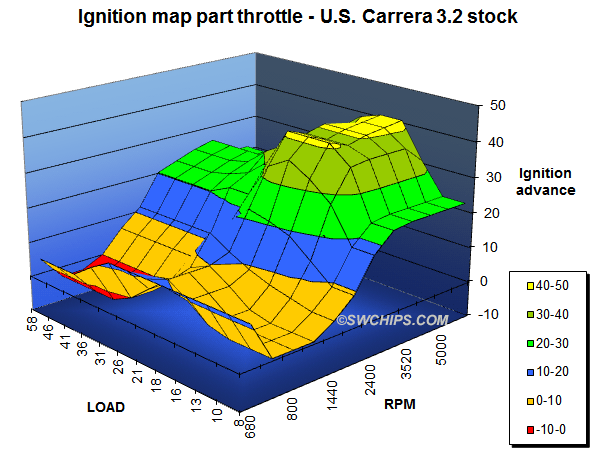
Part
throttle ignition maps from a factory European Carrera
3.2 without O2 sensor and catalytic converter. In the
80s, because super unleaded fuel was not readily available
worldwide to suit the catalyst versions, Euro spec versions
of the Carrera were designed to operate on the super
lead free 95 RON octane fuel. While U.S versions have
a compression ratio of 9.5:1, required 87 (91 RON) octane
fuel, and were rated at 217 hp, the European/R.O.W.
versions had a C.R. of 10.3:1, required 90 (95 RON)
octane fuel, and were rated at 231 hp. Again, there
is much to be optimized here. The same revisions as performed to the U.S. spec cars also eliminates the sub 4000 rpm lag, while providing a significant increase in the everyday drivability, usability, and smoothness of the car. The Euro spec Carrera's character
changes from that of a civilized behavior to one of
a raw race car like performance. Power is increased
by about 16 hp, with a corresponding increase in low and mid end torque and throttle response.
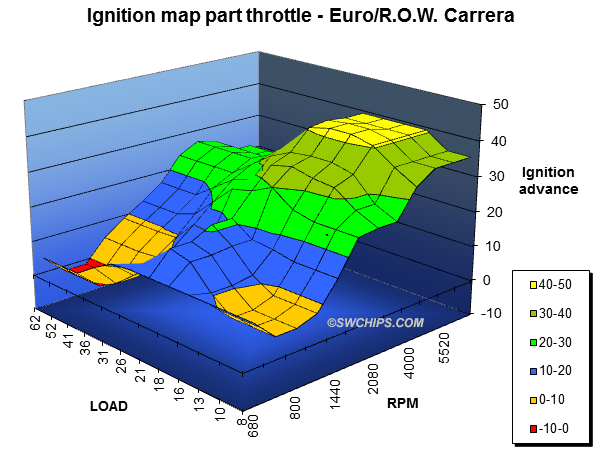
For
years there had been much speculation on why there was
a difference in horsepower ratings between the early
84-86 catalyzed models, and the later 88-89 versions.
With the 84-86 Carrera's rated at 207 DIN hp with a factory
specified 0-60 time of 6.1 seconds and the 87-89 versions rated
at 217 hp, some thought it was just the way Porsche
rerated their engines. The reality is that half of the
later 87-89 Carreras came with a chip with slightly
more aggressive full throttle ignition timing, and the
other half with actually less ignition timing. The full
throttle fuel maps were mostly unchanged. Examining the chart
below, we can see the 1267355358 chip had about 3-4
degrees more ignition advance above 5000 rpm, raising
the peak horsepower to 217, while the 1267355357 was
less aggressive. California and Japan cars jumpered the pin 10 brown wires by the DME reducing overall ignition timing by an additional 3 degrees in addition to further leaning part throttle fuel enrichment, lowering emissions further with a corresponding reduction in performance (California versions
at 200 hp and 6.7 seconds).
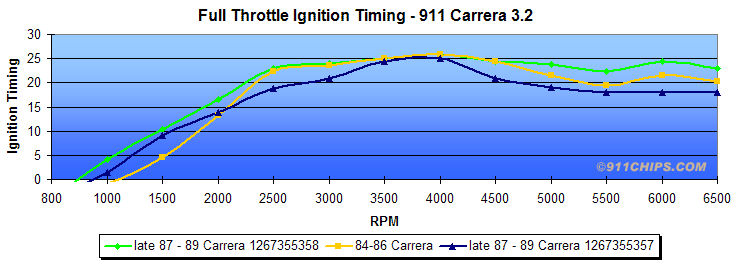
The Porsche 964 and 993
Starting in 1989, with the twin plug motors of the 964 and 993, there are two spark plugs per cylinder which fire simultaneously for more complete combustion. Because the spark is fired from two locations across the cylinder head, the time to total fuel combustion is reduced, reducing the amount of ignition timing advance necessary to achieve the optimum peak pressure point of combustion after passing top dead center. Because of this, the amount of spark advance before TDC of twin plug motors for best power is typically 7-9 degrees less than that required for a single plug 911 motor. The later spark timing required also reduces the energy loss from the piston from having to work against the intial combustion pressure on its way up to TDC, while also allowing the use of higher compression 11.3:1 pistons of the 964s and 993s. The later 996, 997, and Boxster motors with their four valve per cylinder heads allows the spark plug to be located at the optimum central position between all four valves, no longer necessitating the need for twin plugs.
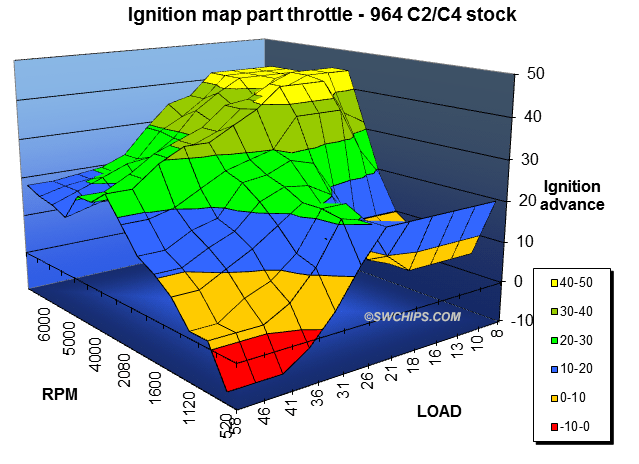
In 1992, Porsche produced a limited production, lightweight variant of the 964 dubbed the Carrera RS for the European market. 2282 road cars were built in three road versions, with another 112 racing only competition versions for its successful European Carrera Cup racing series. While none of these cars were imported or legal for the U.S. market, Porsche Cars North America (PCNA) did import 45 street legal "USA Edition" Carrera Cup cars, to be converted to racing specification for a planned U.S. version of the racing series. Almost as soon as the conversions were finished, the series was cancelled with the cars reverted back to street legal and quietly sold on the open market.
While all these engines were essentially identical to the standard 964, the European RS was factory rated at 260 hp, 10 hp more than a standard 964's 250 hp. The difference was attributed to a proprietary Motronic DME and chip programmed with three degrees more ignition advance, along with unique modifications to improve throttle response. Our dyno tests have measured the 10 hp difference of the Euro Carrera Cup DME setup. Be wary of "cup chip" copies listed on Ebay or elsewhere - real Carrera Cup chips do not work in a standard 964 DME and vice versa. Regardless, we can take the programming of your standard or European RS 964 to real European RS levels or beyond, including full race fuel only versions - contact us for more information.

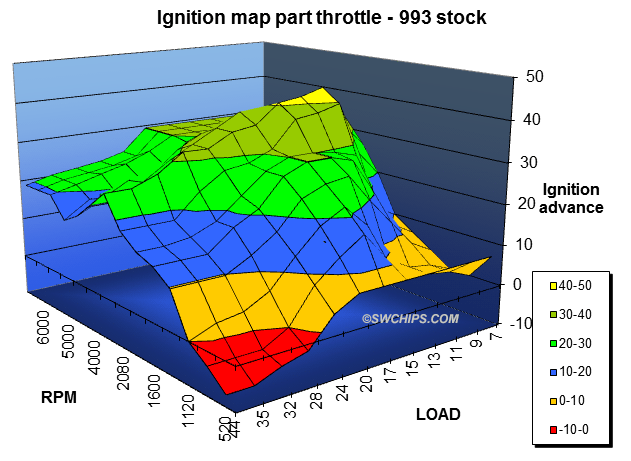

|
